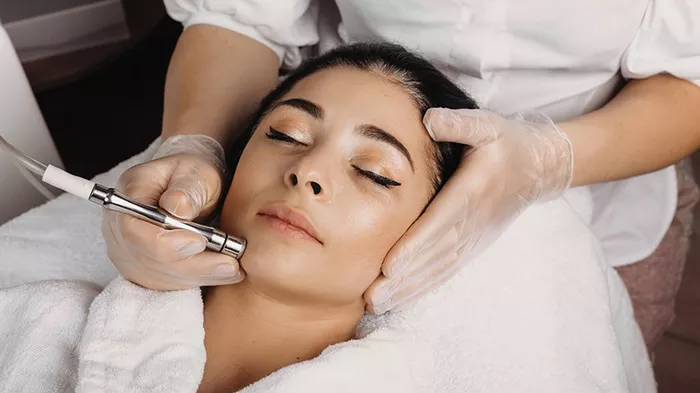If you’re looking for a non-invasive and effective way to rejuvenate your skin, microdermabrasion may be the answer. Microdermabrasion is a popular cosmetic procedure that helps improve the appearance of the skin by exfoliating and stimulating cell renewal. In this article, we’ll explore what microdermabrasion does to your face and how it can benefit your skin.
Understanding Microdermabrasion
Microdermabrasion is a cosmetic treatment that uses a device with a diamond-tipped or crystal-emitting wand to gently exfoliate the surface layer of the skin. This mechanical exfoliation process helps remove dead skin cells, unclog pores, and stimulate the production of collagen and elastin, two essential proteins for healthy skin.
Exfoliation and Skin Renewal
The primary purpose of microdermabrasion is to exfoliate the outermost layer of the skin, known as the stratum corneum. This layer consists of dead skin cells, debris, and impurities that can make the skin appear dull and uneven. By removing this layer, microdermabrasion reveals fresher, smoother, and more vibrant skin underneath.
Exfoliation through microdermabrasion also stimulates the skin’s natural healing process. It triggers cell turnover, encouraging the production of new skin cells. As a result, the skin’s texture improves, fine lines and wrinkles may appear diminished, and the overall complexion becomes more youthful and radiant.
Benefits of Microdermabrasion
Microdermabrasion offers several benefits for the skin, making it a popular choice among individuals seeking skin rejuvenation. Here are some of the key advantages of microdermabrasion:
-
Improved Skin Texture
Microdermabrasion helps refine the skin’s texture by smoothening rough patches and reducing the appearance of acne scars, fine lines, and enlarged pores. The exfoliation process encourages the growth of new, healthier skin cells, resulting in a softer and more even complexion.
-
Enhanced Skin Radiance
By removing dead skin cells and promoting cell renewal, microdermabrasion reveals a fresher, more youthful layer of skin. This can significantly enhance the skin’s radiance and restore a healthy glow.
-
Reduced Hyperpigmentation
Microdermabrasion can be beneficial in reducing the appearance of hyperpigmentation, such as age spots, sunspots, and melasma. The exfoliation process helps break up the excess pigmentation and promotes a more even skin tone.
-
Improved Absorption of Skincare Products
After undergoing microdermabrasion, the freshly exfoliated skin is more receptive to skincare products. With the removal of the outermost layer, serums, moisturizers, and other products can penetrate the skin more effectively, maximizing their benefits.
-
Minimized Acne and Breakouts
Microdermabrasion can help reduce acne and breakouts by unclogging pores and removing excess oil and debris. By keeping the skin clean and free from impurities, microdermabrasion can contribute to clearer, healthier-looking skin.
-
Non-Invasive and Minimal Downtime
One of the significant advantages of microdermabrasion is that it is a non-invasive procedure. It does not require anesthesia or incisions, making it a safe and relatively painless option for skin rejuvenation. Additionally, the procedure typically has minimal downtime, allowing individuals to resume their daily activities immediately.
The Procedure and Frequency
Microdermabrasion is typically performed by a licensed aesthetician or a dermatologist. The procedure is generally straightforward and can be completed in a short amount of time.
During the treatment, the practitioner will use a handheld device with a diamond-tipped or crystal-emitting wand to gently glide over the skin’s surface. The wand delivers a controlled stream of exfoliating crystals or uses diamond tips to abrade the skin. The level of exfoliation can be adjusted based on individual skin needs and concerns.
After the procedure, a hydrating and soothing moisturizer is usually applied to the skin to help replenish moisture and promote healing. It’s essential to protect the treated skin from direct sunlight and apply sunscreen to minimize the risk of sun damage.
The frequency of microdermabrasion treatments can vary depending on the individual’s skin type, concerns, and desired outcomes. In general, a series of treatments is recommended to achieve optimal results. These treatments are typically spaced two to four weeks apart, allowing the skin to heal and rejuvenate between sessions.
Who Can Benefit from Microdermabrasion?
Microdermabrasion is a versatile treatment suitable for a wide range of skin types and concerns. It can be beneficial for individuals who want to improve the overall appearance and texture of their skin. Microdermabrasion is often used to address:
- Dull or uneven skin tone
- Fine lines and wrinkles
- Age spots and sun damage
- Enlarged pores
- Acne scars
- Hyperpigmentation
- Mild to moderate acne
However, it’s important to note that microdermabrasion may not be suitable for individuals with certain skin conditions, such as active acne, rosacea, or sensitive skin. It’s best to consult with a skincare professional to determine if microdermabrasion is right for you and to discuss any specific concerns or contraindications.
Conclusion
Microdermabrasion is a highly effective and non-invasive cosmetic procedure that offers multiple benefits for the skin. By gently exfoliating the outermost layer and stimulating cell renewal, microdermabrasion can improve skin texture, enhance radiance, reduce hyperpigmentation, and minimize acne and breakouts. It is a safe and convenient option for individuals seeking skin rejuvenation with minimal downtime. Consult with a qualified skincare professional to determine if microdermabrasion is suitable for your skin needs and to develop a personalized treatment plan that will help you achieve your desired results.


